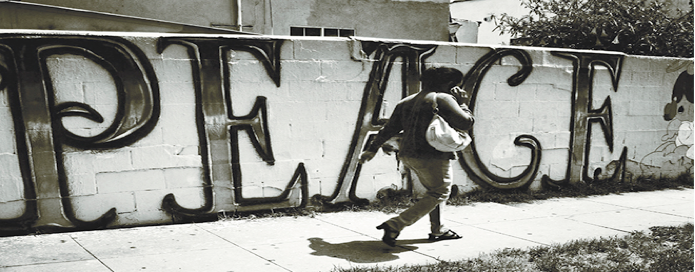WHO WE ARE- Los Angeles gave America the modern street gang. Groups like the Crips and MS-13 have spread from coast to coast, and even abroad. But on Southern California’s streets they have been vanishing. Has LA figured out how to stop the epidemic it set loose on the world?
In 2007, when housing prices were still heated, factory worker Simon Tejada put his home on the market. It was a well maintained three-bedroom in the Glassell Park district of Northeast Los Angeles, and the structure was appraised at $350,000. (Tejada had bought it for $85,000 in 1985.) But only one offer came in: $150,000. “Your house is fine,” the guy told Tejada. “The neighborhood’s awful.”
I met Tejada a few months later. I had been writing about gangs in Los Angeles since 2004, when, after 10 years as a writer in Mexico, I’d returned home to take a job with the Los Angeles Times. My reporting took me into scores of working-class neighborhoods and cities within Southern California, places like Pacoima, Watts, Azusa, Hawaiian Gardens, Florence-Firestone, and Harbor Gateway.
Gangs ravaged all these locales. Walls were covered with graffiti. Shootings were constant. In many of these neighborhoods, Latino gangs had taken to attacking and killing random black civilians, turning themselves into the leading regional perpetrators of race-hate crime.
Yet no place was as scary as the densely built two-block stretch around the corner from Simon Tejada’s house in Northeast LA Along those blocks, just south of the Forest Lawn cemetery, ran Drew Street, a stronghold of the Avenues, a Latino gang.
I sat with Tejada in his home, shrouded behind a high wall and thick hedges, as kids in hoodies stood among densely parked cars outside and nodded at potential customers driving by. They carried on an unceasing trade in crack cocaine, with the apartments as their base. Graffiti was everywhere. When the police drove down Drew Street, it was two cars at a time, to the sound of gang whistles and Nextel chirps.
Six years later, on a sunny afternoon, I went back and found that Simon Tejada never sold his house. I met him this time outside the home, and we walked the street freely. Gone were the thugs in hoodies. Gone was the graffiti. As we strolled, Tejada waved to neighbors, some of whom had just bought houses. “Now I don’t want to leave,” he told me.
The transformation of Drew Street is not unique. In the past few years, street gangs have been retreating from public view all over Southern California. Several years ago, I spent a couple of days in the Florence-Firestone neighborhood, in an unincorporated part of Los Angeles County, interviewing some Florencia 13 gang members.
One nearby garage was never free of graffiti for more than a few minutes a week. (This was the amount of time it took after the graffiti clean-up truck left for the 76th Street clique of Florencia 13 to re-deface the thing.) That garage wall has now been without graffiti for more than four years. I go by it every time I’m in the neighborhood.
Fifteen miles southeast of Florence-Firestone, much of the tiny city of Hawaiian Gardens used to be scarred with the graffiti of HG-13, a local gang that absorbed several generations of the town’s young men. The last three times I’ve been to Hawaiian Gardens, I’ve seen nothing on the walls, and young black men freely visit taco restaurants on the main drag, something that would have been inconceivable a few years ago. In Oxnard’s Colonia Chiques neighborhood in Ventura County, the decades-old neighborhood gang is not outside, and their graffiti is gone.
Some of this is a state and national story, as violent crime declined by about 16 percent in both California and the nation from 2008 through 2012. But the decline has been steeper in many gang-plagued cities: 26 percent in Oxnard, 28 percent in Riverside, 30 percent in Compton, 30 percent in Pasadena, 30 percent in Montebello, 50 percent in Bell Gardens, 50 percent in El Monte.
Santa Ana once counted 70-plus homicides a year, many of them gang-related. That’s down to 15 so far in 2014, even as Santa Ana remains one of the densest, youngest, and poorest big cities in California. “Before, they were into turf,” says Detective Jeff Launi, a longtime Santa Ana Police gang investigator. “They’re still doing it, but now they’re more interested in making money.”
No place feels so changed as the city of Los Angeles. In 2014, the Los Angeles Police Department announced that gang crime had dropped by nearly half since 2008. In 2012, LA had fewer total homicides (299) citywide than it had gang homicides alone in 2002 (350) and in 1992 (430). For the most part, Latino gang members no longer attack blacks in ways reminiscent of the Jim Crow South.
Nor are gangs carjacking, assaulting, robbing, or in a dozen other ways blighting their own neighborhoods. Between 2003 and 2013, gang-related robberies in the city fell from 3,274 to 1,021; gang assaults from 3,063 to 1,611; and carjackings, a classic LA gang crime born during the heyday of crack, from 211 to 33.
“Being the member of a gang doesn’t have the panache it did,” says George Tita, a criminology. “Things have changed radically in the last five years.” (Read the rest … including Sam Quinones’ thoughts on the future of gangs in Los Angeles … here)
-cw
CityWatch
Vol 12 Issue 2
Pub: Jan 6, 2015
{module [862]}
{module [662]}
Explore
Our mission is to promote and facilitate civic engagement and neighborhood empowerment, and to hold area government and its politicians accountable.

 CityWatch Los Angeles
Politics. Perspective. Participation.
CityWatch Los Angeles
Politics. Perspective. Participation.
18
Tue, Nov




